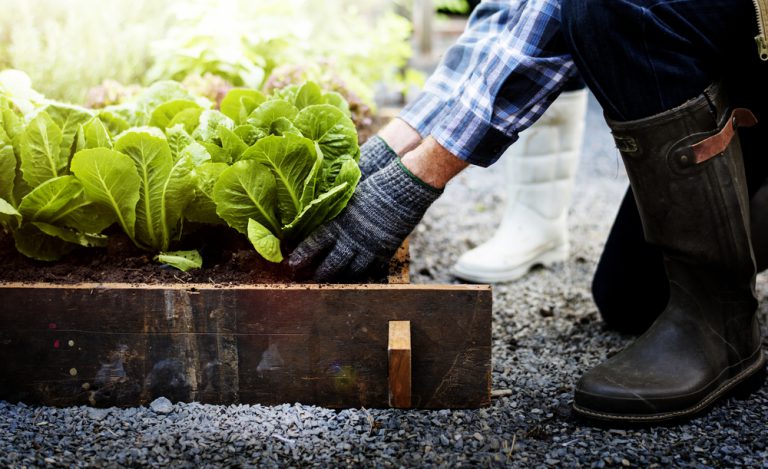
There’s plenty to love about the RV lifestyle – so much so that many campers find themselves transitioning to full-time RV living. We get it – all that freedom to pick up and do whatever you want without having to worry about who will watch your home while you’re out there enjoying the world.
Full-timing can also be a great way to cut down on expenses and create a sustainable lifestyle. But the same attraction to minimalism that draws people to the RV lifestyle in the first place also often leads them to grow their own garden… and it’s pretty tough to have a garden if you don’t have any stable plots of land.
Or is it?
Some inventive RVers out there have found creative ways to maintain RV gardens even while they’re on the road. They have mobile home gardening ideas if you’re looking for a way to indulge this fun and fulfilling hobby. From creative ways to use shoe organizers to mason jars, here are some of the best portable garden ideas we’ve found around the web.
How do you garden in an RV?
As you likely already know, one of the limiting factors when it comes to RVing is space. Even large, luxurious vehicles have precious little storage room and even less countertop square footage.
But necessity is the mother of invention, and gardeners aren’t the type to give up easily! Here are a few unique ideas for growing a garden on wheels.
1. Try a Shoe Organizer Garden
As a full-time RVer, you may already use shoe organizers for all sorts of purposes (aside from, you know, actually organizing shoes). These cheap accessories are insanely versatile and useful… but we have to admit, we’d never have thought of this idea!
Instead, the credit goes to camper Sue Moore, who shares a 22-foot Keystone Bullet Premier trailer with her husband. An avid gardener who was considering hitting the road for an extended period of time, Moore wanted to bring along her gardening hobby even while she and her husband were globe-trotting. So she decided to experiment with — you guessed it — shoe organizers, and honestly, the idea is pretty genius.
Of course, it’s not as simple as just throwing potting soil into the pockets and letting nature take its course. Moore recommends using a lighter substrate, like a mix of starting seed mix, perlite, and peat moss, to keep the hanger from getting too heavy. It’s also a good idea to choose plant varieties that won’t grow take over the rest of your seedlings. (Moore’s got some fun and tasty suggestions: strawberries, buttercrunch lettuce, spearmint, Spanish onion, and stringless blue lake green beans.)
You can also implement Moore’s clever idea for water conservation by placing the rack above any potted plants you have. This way, the water that drips out of the hanging planter will water the pots below — and you’ll also minimize any dirt. (Pro tip: when you’re actually in transit and on the road, place the hanging rack setup in your RV shower!)
2. Make it Work with Mason Jars
Sprouts and microgreens are increasingly popular these days, adorning all manner of upscale salad bars and grocery store shelves. They also tend to cost way more than you might want to spend to add a little crunch to your lunch plate.
But if you’re looking for ways to up your micronutrients while also exercising your green thumb, there might just be a solution.
Mason jars have all sorts of uses, but we have to admit, we probably wouldn’t have thought of this one ourselves! The credit goes to Amanda Watson, who shares a 25-foot Airstream trailer with her husband Tim and blogs about the experience over at WatsonsWander.
Using nothing more than wide-mouth mason jars, fine mesh screens, rubber bands, and seeds, you, too, can start your very own sprouting garden — even if you’re traveling in a small RV or travel trailer. There are plenty of delicious and nutritious veggies that will create delectable sprouts. Add these to salads or add crunch to your favorite sandwich. Here are just a few potential sprouting plants to consider:
- Alfalfa
- Chickpeas
- Mung Beans
- Adzuki Beans
- Clover
- Lentils
- Radish
- Cress
- Broccoli
- Sunflowers
Here’s how it works. Place 2-4 tablespoons of your seed of choice into the bottom of a mason jar, and then fill the jar with enough room-temperature water to submerge the sprouts by an inch. Secure your mesh screen on top of the jar with a rubber band. Place the jar in a cool spot away from direct sunlight overnight or for 8-10 hours.
Then, you drain the water through the mesh top, leaving the jar on its side in a cool spot. Rinse the seeds twice a day by filling the jar, swishing the water around, and then draining. Repeat until you’ve got the sprouts you want. Simple, right? And also super satisfying!
3. Turn Your Whole RV into a Greenhouse!
Okay, this one might sound kind of extreme… and we’re not suggesting you replace your whole RV body with glass. (Although that would look pretty cool.)
But if you’re willing to experiment a bit, there are plenty of plants that grow in low light, including vegetables like Brussels sprouts, carrots, and cauliflower.
While these plants still need some light and water, you may be able to get by with potting them and keeping them inside your rig, so long as you put them outside when you’re stopped. For more information about plants that tolerate shade, check out this post over at Harvest to Table.
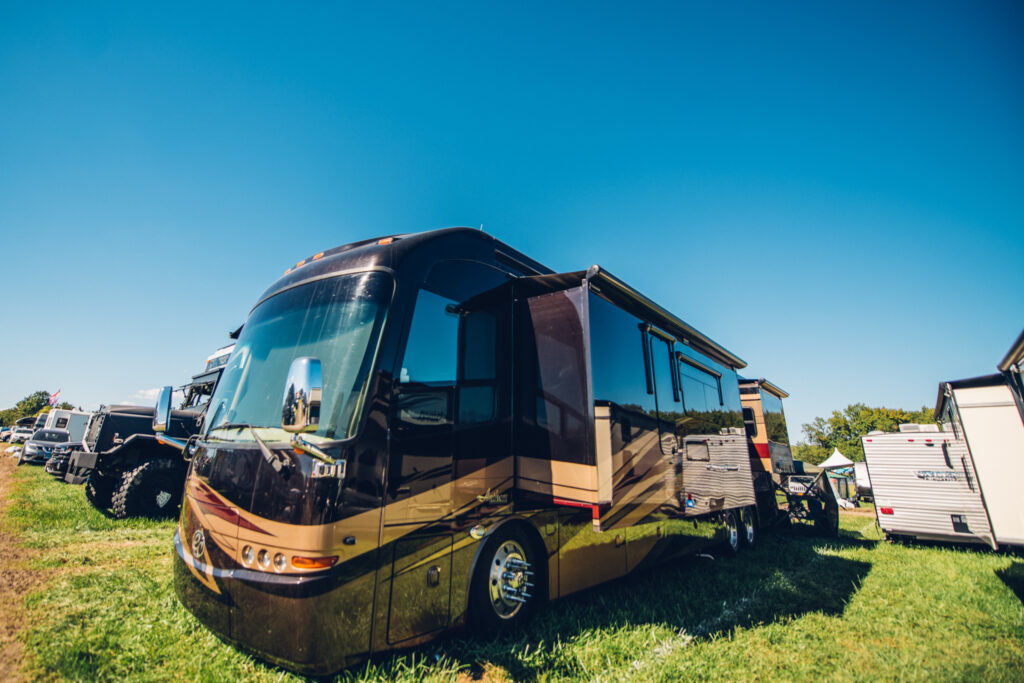
More Mobile Home Garden Ideas
Herbs
You can grow your herbs in mason jars as well or other pots depending on how big they get. Herb gardens are perfect for RVs because they can be cared for with artificial light if natural light is not available.
Tips for growing an RV herb garden:
- Put in loose, fast-draining soil
- Let the soil dry in between waterings
- Keep the soil wet, not soggy
- Separate herbs in their own pots, as watering and light needs can vary
Easy to care for herbs:
- Basil
- Mint
- Oregano
- Parsely
- Rosemary
- Thyme
Vegetables
As mentioned above, some vegetables thrive in low light, making them great for RV life. If you are stopped long enough, there are great vegetables that can be grown in window boxes or pots.
- Tomatoes
- Green beans
- Peppers
- Radishes
- Spinach
- Peas
- Lettuce
- Squash
- Cucumbers
The care needs for these vegetables can vary. Some require a lot of direct sunlight, like tomatoes and cucumbers. Some are climbers, like green beans and peas. And others can thrive in lower-light conditions, like spinach. But all can do well in pots, which makes them great for mobile home gardening!
RV Garden Supplies
Supplies for RV gardening depend on what you’re doing, but at the bare minimum, you need a container, a substrate, and a plant!
Here are some of the goodies you need to get started with the gardening methods we’ve mentioned above.
Portable Garden Box
Another option is to use a portable garden box, which you can stick outside whenever you get to a campground. You can keep the box in your RV’s bathroom or shower when you’re underway to minimize mess. It’s a great way to enjoy the luxury of freshly grown veggies, fruits, or whatever else you’d like to garden!
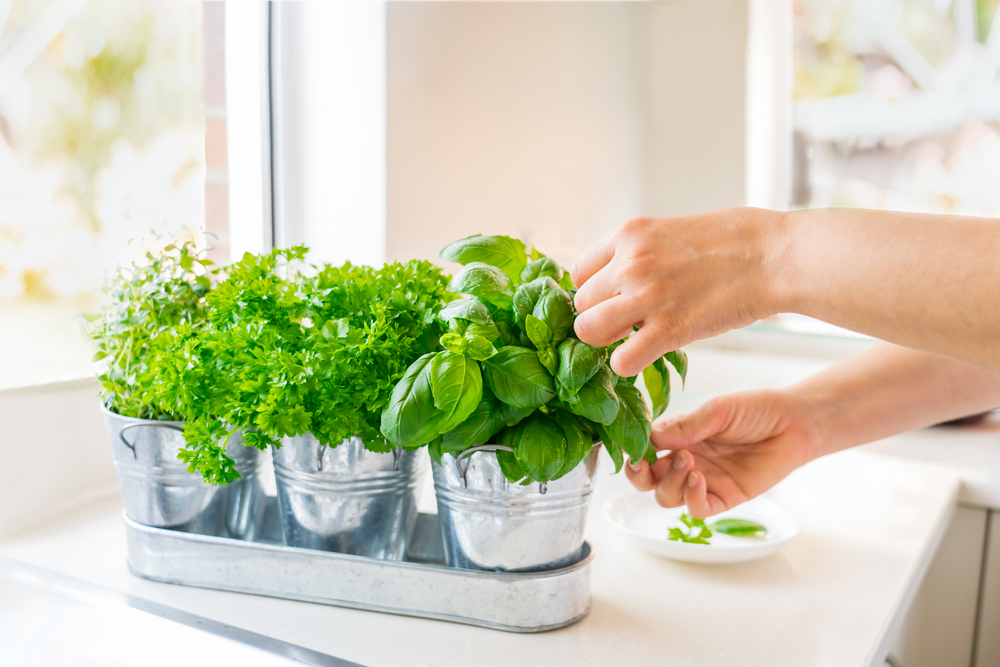
Creating an Indoor Herb Garden
The most important thing for beginners to know when they’re considering an indoor herb garden is that most herbs require as much light as possible. Although some herbs and vegetables can survive in low light conditions, the majority of the popular ones you’ll want to add to your dishes, like parsley, sage, rosemary, thyme, and oregano, all benefit from getting as much sun as you can muster. So your first move is to find a particularly bright window in your rig.
Of course, your RV isn’t stationary. (That’s the whole point!) So keep your herb garden in mind when you change your rig’s orientation. Try to keep your herb pots in an east-facing window, if possible, so they’ll get a full-on blast of sunshine each morning.
You can start a basic herb garden with only a few basic necessities: small pots with draining dishes (ceramic will keep the soil nice and dry, which can keep your herbs from rotting), potting soil, and, of course, the seeds your herbs will grow from. You could also consider purchasing mature plants if you don’t want to wait before using them in your recipes.
Some of the best herbs for an indoor herb garden include chives, lemon balm, and mint, which are all quite hardy. Cilantro is another popular indoor herb garden addition, so long as you’re traveling with people who like it!
There are also lots of easy indoor herb garden kits available if you don’t want to assemble all the ingredients you need from scratch, and some of them are quite decorative. For example, this cute cedar wood planter comes with many different seeds to choose from, with each pot having a chalk label so you can change up your herbs seasonally.
Another important consideration for RVers specifically is that some states have restrictions on bringing plants across borders since soil can harbor pests and diseases. But you can bypass that problem if you utilize a hydroponic growing system for your herb garden — there are many available on the market today, and they’re not as expensive as you might imagine.
Caring for an Indoor Herb Garden
No matter which kind of setup you choose, it’s important to learn how to properly care for your indoor herb garden if you want it to stay healthy and ready to use. Different plants have different water and light requirements, so you’ll need to look at your herb choices to see what they need.
For example, if you try to grow basil, a particularly light-hungry plant, you may do best with artificial grow lights or putting the planter outdoors. Some herbs may also do better with the addition of fertilizer. It’s a good practice to choose herbs that have the same general needs to simplify your garden maintenance.
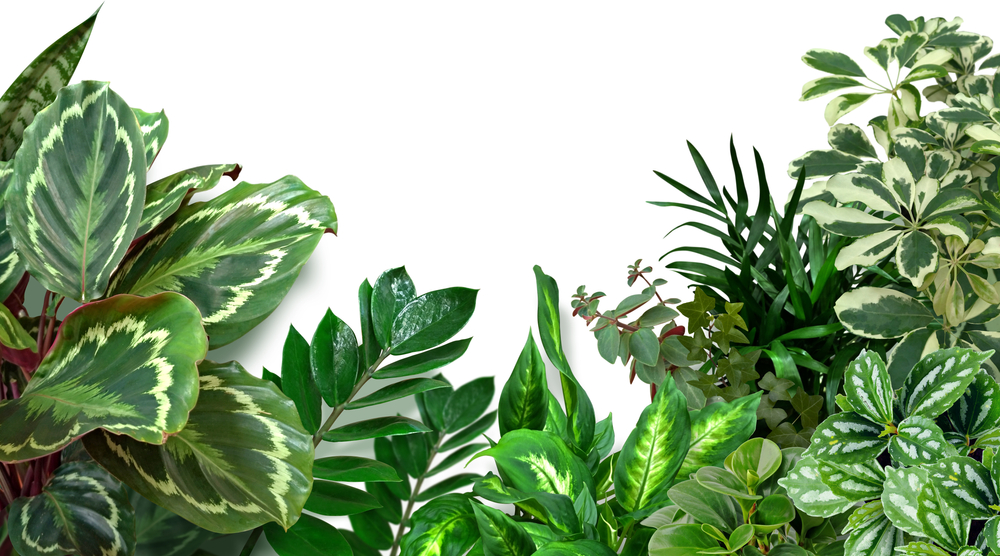
Indoor Plants that Do Well in Shade
Pretty much all plants need some sunlight to grow since they use it to make their own food supply.
However, some plants do well in partial shade or low-light conditions and need just a little sun. Still other indoor plants thrive in artificial or fluorescent light, making them much more adaptable to small spaces like your motorhome. This is good for you, since it means you get to have all the benefits of indoor plants while you’re busy checking off your list of destinations!
So, what are some of these plants that don’t require full sun to function? We’ll give you all the details below.
What Indoor Plants Like Shade?
Even if you’re no green thumb, these indoor plants will thrive in your RV.
All of these indoor plants do well in low sunlight and most of them don’t require much in the way of watering, fertilizing, or trimming. Best of all, they’re all readily available at your local garden shop or hardware store, or even online through Amazon!
1. Chinese Evergreens
With thick green leaves rimmed in a stunning pinkish-red, Chinese evergreens — also known as Aglaonema — require very little in the way of care. Not only do they do well in low light, but they’ve adapted to survive drought conditions, which means they can go long periods between watering!
Of course, even though it’s hardy, it still needs some love. And when it’s well taken care of, you’ll be rewarded by beautiful white blooms poking up through the greenery.
2. Bamboo
Bamboo is a very popular low-light houseplant, and for good reason — it’s widely considered to bring luck to its household!
Furthermore, since they’re so popular in offices and homes, they’re available almost everywhere, and they’re fairly cheap, to boot.
Potted Plants for Motorhomes
Here are some more great potted plants to grow in motorhomes.
3. Philodendron, or “Heart Leaf”
Considered by many to be the easiest indoor plant to grow, potted philodendrons can be placed on the floor, counter, or hung in baskets. Their heart-shaped leaves bring a touch of whimsy to any space. Just make sure you don’t put them in direct sunlight – they hate that!
4. ZZ Plant
No, it’s not named after the rock band! This sturdy green plant’s technical name is zamioculcas zamiifolia, which is quite a mouthful.
As hard as it is to pronounce, however, ZZ plants are super easy to grow! They freshen up rooms even with very little sunlight.
5. Boston Fern
Another very popular indoor plant option, Boston ferns can be seen hanging in planters and propped up on countertops across the country. They’ll do great in your RV, requiring only a little bit of light and some humidity — and rewarding your minimal efforts with a full, bright-green shock of foliage!
Flowering Plants that Don’t Need Direct Sunlight
Big green leaves are great and all, but sometimes, you want a little bit of color.
Unfortunately, many of your favorite flowering plants, like lavender and kalanchoe, do require lots of sunlight. However, there are also some lovely indoor flowers that don’t need very much sun at all!
6. Anthuriums
Coming in a broad range of bright colors, anthuriums boast beautiful, waxy flowers that bloom even without direct sunlight. In fact, all they require is a simple weekly watering, and the blooms should last for two to three months!
7. Peace Lilies
Who would have suspected that one of the most graceful, beautiful flowers would also be one of the easiest to care for?
Peace lilies don’t require much light at all, and as long as you keep the soil moist, you don’t need to worry too much about watering them. Plus, they emit a beautiful fragrance, especially in the evenings. What better way to bring some serenity to your motorhome?
8. Climbing Hydrangea
If you’re set up for a longer period of time and have some lattice to use as a trellis, you can grow climbing plants to make your RV patio more inviting.
Climbing hydrangea is one of the few climbing plants that don’t need much sun. They also have fragrant white flowers that will make your RV’s outdoor living space a popular spot.
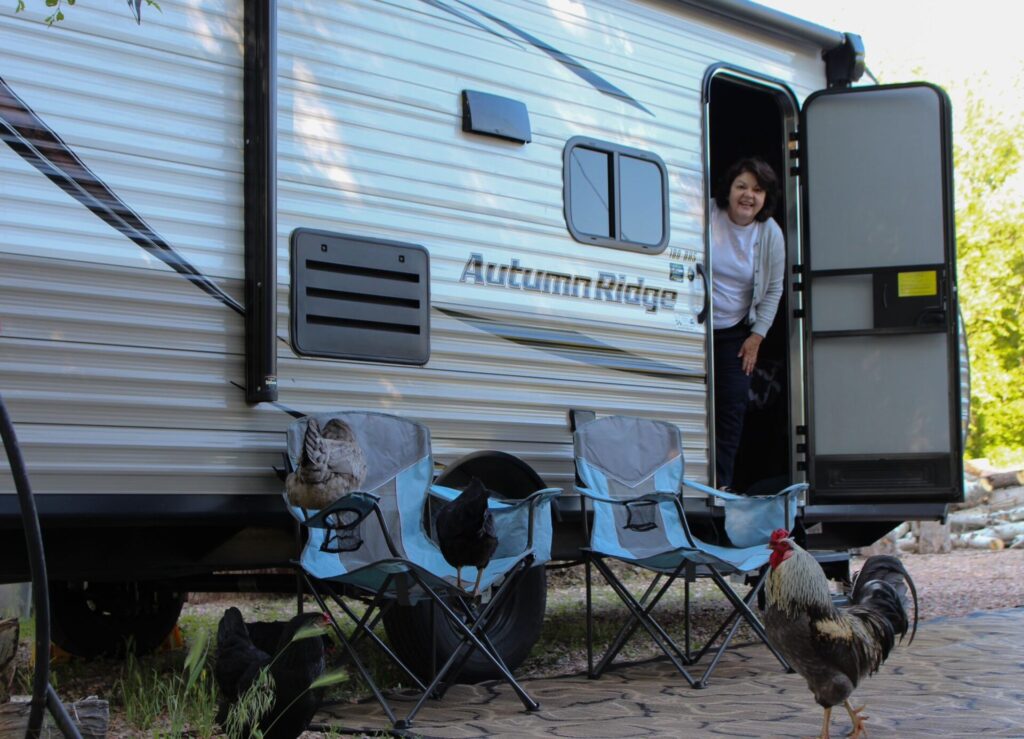
RV Landscaping Ideas
If you’re the kind of full-timer who sets down roots for a few months, you can invest in ways to create a beautiful RV landscape. Simple touches like adding LED torches along your walkway can go a long way toward making your RV plot feel more like home. Of course, it’s important to ensure that the owners of your campground are on board before you start making exterior changes!
Popular Plants by Region
If you’re setting up camp for several months, you’ll want to know what will grow in your area before you plant. Even if you’re just passing through, many avid gardeners like to know what plants and flowers grow in the regions they’re visiting.
Popular Plants that Grow in the Midwest
Deep in the heart of it all, some of the most beautiful blooms are waiting.
Black-Eyed Susan
Native to eastern and central North America, the black-eyed Susan is one of the most popular wildflowers not only to spot along the trail but also to include in bouquets and arrangements. The stark juxtaposition between its dark center and cheerful yellow leaves draws the eye. In gardens, the blooms attract birds and butterflies.
American Indians once used the root of the black-eyed Susan to make a tea for colds, and even used its extract to treat ear aches. A wash made of the plant could also be used externally on sores, swellings, and snake bites.
White Dogwood Tree
A drive through the countryside might leave you wondering when the Midwest got all those cherry or pear blossoms… but what you’re actually seeing is more likely the white dogwood tree. It was once one of the most widespread types of plants in the country.
Although perhaps best known for its showy white spring blossoms, the tree also turns a beautiful red-purple color in fall. It also has red fruits during this time that draw winter songbirds, making the trees a lovely addition to any front yard.
American Water Lotus
The American water lotus blooms with pale but fragrant yellow flowers in wetlands all along the Mississippi River. They’re particularly common in Ohio, where they’re sprinkled across the shallow inlets of ponds and lakes.
Some fun facts about the American water lotus: Its blooms can reach up to 10 inches in diameter, and unlike other types of aqueous flora, its roots dig into the ground beneath the water and spread by rhizomes. (Other types of water-dwelling plants simply float on the water itself.) Beavers and muskrats use those rhizomes as a food source, making these plants an important part of the larger midwestern ecosystem.
Click here to see RVshare rentals in Ohio.
Click here to see RVshare rentals in Michigan.
Click here to see RVshare rentals in Illinois.
Click here to see RVshare rentals in Kansas.
Click here to see RVshare rentals in Wisconsin.
Click here to see RVshare rentals in Indiana.
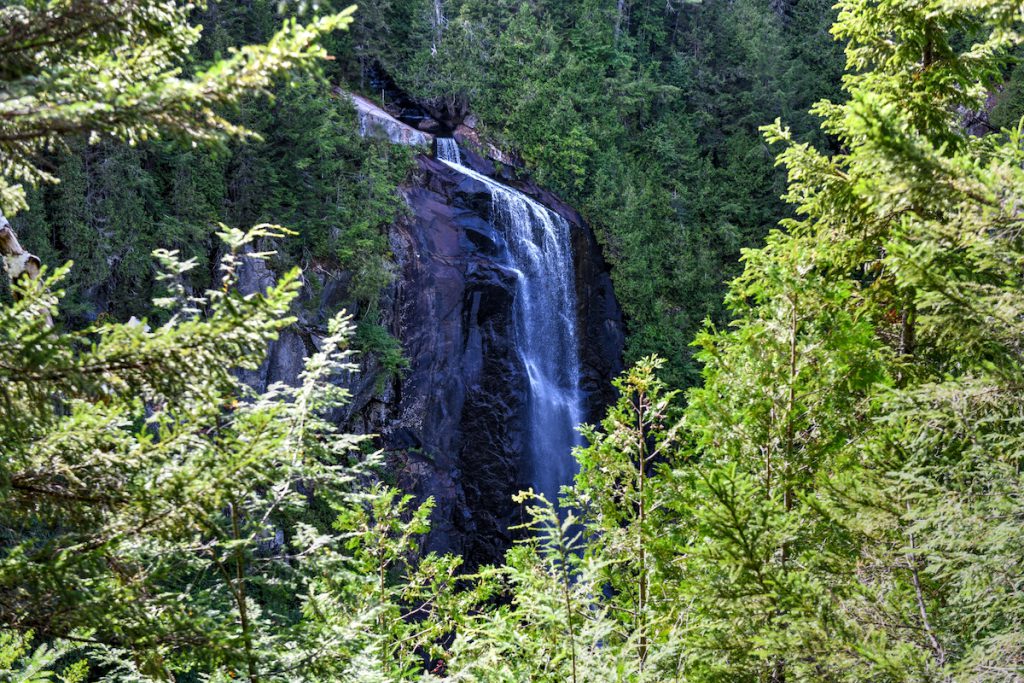
Popular Plants that Grow in the Northeast
Quaint towns, tons of history, and some of the best native plants in the country — here’s what to keep an eye out for when you head northeast.
Blue-Eyed Grass
With flattened, leaf-like stems growing up to 18 inches in height, the deep-blue, star-shaped blooms on this native North American plant make it so much more exciting than its name implies. Yellow centers make for an even more lovely flower, which bears a lot of resemblance to the larger iris family.
Interestingly, there’s generally only one flower in bloom at a time, though the plant grows in dense clumps which means you’ll likely see a spangle of many blue blooms at once. These plants can be seen in a wide variety of U.S. states across the northeast and beyond and are viable as far north as Canada.
Cinnamon Fern
Otherwise known by its scientific name, Osmunda cinnamomea, cinnamon ferns undergo a series of changes throughout their lifespan, starting as furry fiddleheads before sprouting stiff and erect pinnae, whose spikes of fruit dots change from green to the chocolate brown color that gets the plant its name. Like other ferns, the sterile green fronds eventually bend outwards, creating a vase-shaped circle around the cinnamon fronds themselves.
The sterile fronds of these native ferns can grow up to five feet long, and blooms are best observed in May and June. Look in boggy areas, shaded ledges, and bluffs for the best chance of catching a glimpse of them.
Northern Red Oak
These stunning trees are part of what gives the northeast its reputation for being a great place to go leaf-peeping in fall. Growing up to 75 inches in height, they’re relatively squat… but their bright red leaves make them stand out regardless of their stature.
These trees grow at a remarkable clip, with healthy plants increasing in height at a rate of 24 inches or more per year. They prefer full sun, so look for them in bright, open fields and along sunny hiking trails, where their crowns — which can reach up to 45 inches in spread — provide wonderful shade.
Click here to see RVshare rentals in Maine.
Click here to see RVshare rentals in New Hampshire.
Click here to see RVshare rentals in Vermont.
Click here to see RVshare rentals in Massachusetts.
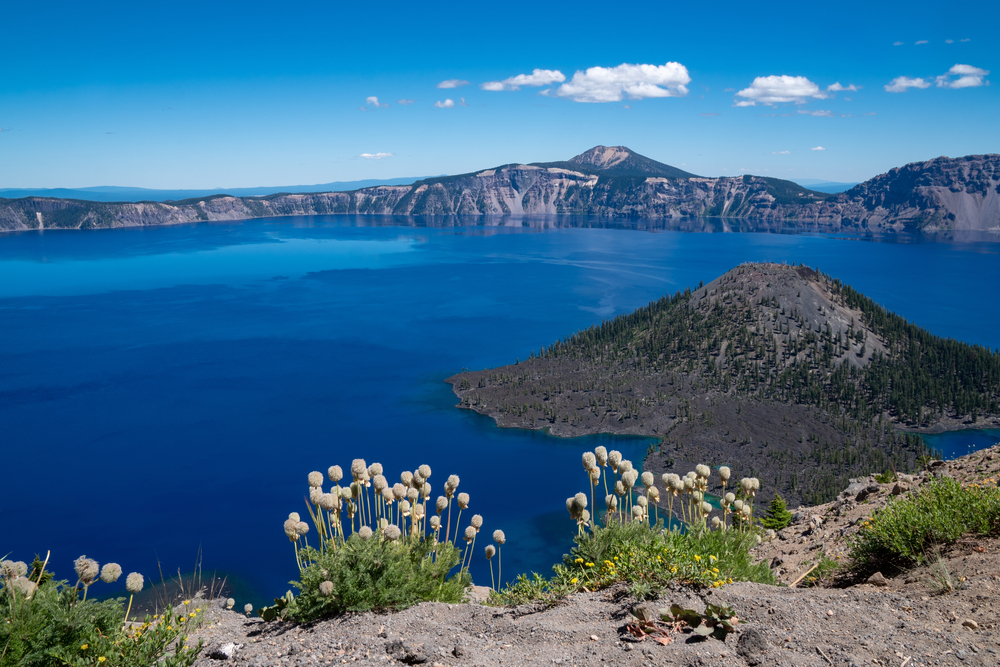
Popular Plants that Grow in the Pacific Northwest
The last living American rainforest, the Pacific Northwest is home to some of the best native plants in the book. Here are a few of our favorites.
Douglas Fir
That’s right, the tree that’s gained so much Christmas-time fame is a native of the Pacific Northwest — and is also pictured on the Oregon state license plate. These towering evergreen conifers can reach up to 330 feet in height, though the average is closer to 70-100 feet. (The really big ones grow near the coast!)
Along with being an impressive sight, Douglas fir is also useful in a wide variety of lumber applications, from flooring to furniture and beyond. It’s known for its combination of strength and versatility.
Evergreen Huckleberry
Hikers who frequent the West will likely be familiar with this tasty treat, which makes for a great trail snack while it’s in bloom. (It can also be found at farmer’s markets and roadside stands as well.)
Tribes in British Columbia and western Washington state have long used these berries, which were eaten fresh, with oil, or even sun- or smoke-dried. They could also be mashed and pressed into a cake or wrapped in leaves… though today, we recommend simply plucking them from the vine and eating them (so long as you know for sure how to identify them — we recommend asking a local to show you!).
Pacific Rhododendron
Visible in front yards and along trails throughout the Pacific Northwest, these evergreen shrubs are outfitted with beautiful fuschia blooms that grace the plants from April through July. Requiring a lot of water and partial shade, it’s no wonder these rhododendrons do so well in this region, which is also their native home. However, the plants are highly toxic, and no part of the flower, stem, or leaves should be ingested or even made into honey!
Goldenrod
A perennial plant that has been long hailed for its healing properties, goldenrod most often grows in an “inflorescence,” which is to say a vast field of plants altogether. Although characteristics vary, goldenrod leaves are generally small, measuring less than five inches long and only about half an inch in width, with dozens of tiny, golden flowers.
Goldenrod is a member of the Asteraceae family, which is widespread across the globe and present on every continent with the exception of Antarctica. There are multiple species that can be difficult to differentiate from one another, but chances are you’ll see some during your Pacific Northwest adventure.
Hardhack
The common name for Rose spirea doesn’t do much to communicate its delicate beauty. Also known as Douglas’ spirea, these ephemeral pink blossoms provide ground cover in the same areas populated by those towering trees mentioned above.
Hardhack is particularly common alongside rivers, where it forms dense thickets clustered with the blooms. The flowers themselves emerge in early summer and are bright pink at their peak before slowly turning a darker color as the fall draws nearer.
Click here to see RVshare rentals in Oregon.
Click here to see RVshare rentals in Washington.
Click here to see RVshare rentals in California.
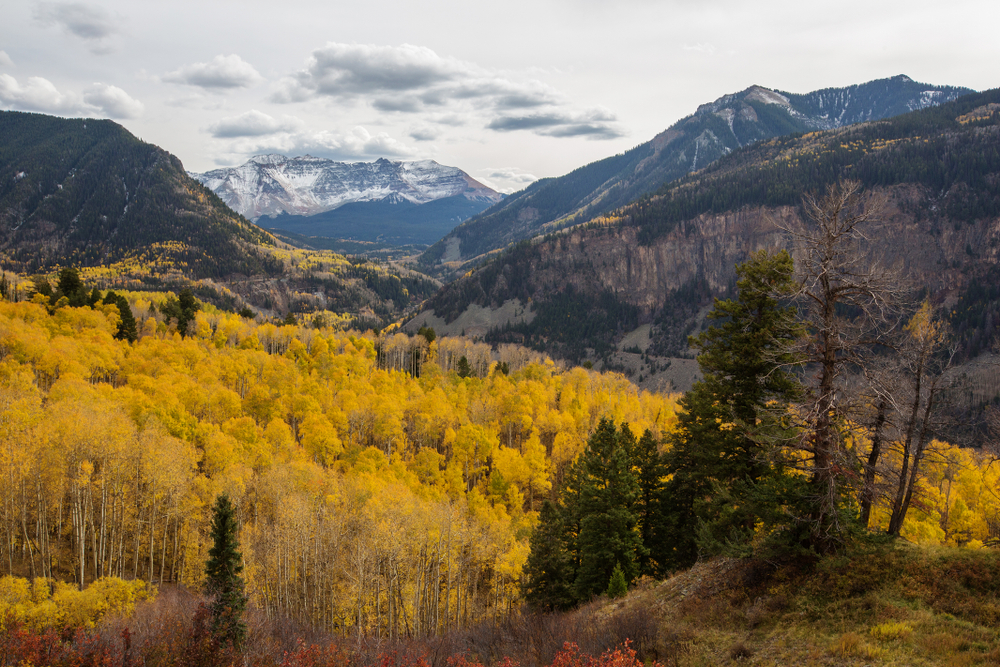
Popular Plants that Grow in the Rocky Mountains
Seeking a Colorado Rocky Mountain high? Don’t forget to keep an eye on the ground to identify these plants while you’re at it.
Wild Rose
Although it’s quite different from the thorny kind you may be familiar with from Valentine’s Day bouquets, the Rocky Mountain region does have small wild roses, which are pink in color and have fragrant blossoms that can reach up to four inches in breadth. To spot them, look about ten feet up from the trail, where they dot the understory of aspen forest. Fun fact: these showy blooms usually last only a single day!
Kinnikinnick
Otherwise known as common bearberry, these plants are a staple in the diet of — you guessed it — local bears. The word “kinnikinnick” comes from Algonquin, where it refers to a wide variety of tobacco substitutes. The natives used bearberry for several different medicinal purposes, including as a laxative.
Before the red berries themselves come into season, the plant offers lovely, bell-shaped flowers in pink or white which are visible from many Rocky Mountain-area hiking trails. The berries are long-lived, often staying on branches into the winter months.
Columbine
These delicate blue and white blooms are easy to grow and are thus often found growing wild in many areas of the country, including the Rockies. Along with its showy spring blooms, the green foliage of the plant turns maroon in fall.
Click here to see RVshare rentals in Colorado — and don’t forget our insider guide to Rocky Mountain National Park!
Popular Plants that Grow in the Southeast
Hot and humid, the Southeast is home to a host of beautiful flowers and other plant life. Here are some of our favorites.
Venus Flytrap
These famous, carnivorous plants are actually native to North and South Carolina… and are also the subject of a multi-level crime ring. (Yes, seriously; you can hear all about it on the podcast Criminal.) Currently endangered, there’s a large market for these unique plants in nurseries and novelty stores alike — but we think they’re best observed in their native habitat. (And don’t pick any!)
Bottlebrush Buckeye
Ranging from six to 12 feet in height, bottlebrush buckeye grows in dense thickets of mound-shaped shrubs, with its lowest branches resting horizontally along the ground. Its ascending branches have been described as “candelabra-like,” forming picturesque scenery in the southeast that often persists well into fall.
These plants like partially shady environments and their native distribution ranges from Georgia to Alabama and South Carolina, though generally not as far south as Florida. They attract hummingbirds and butterflies, so be sure to look for some flying friends when you spot some!
Beautyberry
Also known as French mulberry, beautyberry is actually a plant native to America, with a broad distribution in the southeast. It grows in the understory of the dense southern oak forests, tolerating a wide range of soils from moist to sandy to loamy.
Although beautyberries may be, as their name implies, beautiful, they are not suitable for human consumption. However, they are an important food source for many species of birds, and Native Americans used the root and leaf teas made from the plant in sweat baths to treat rheumatism, fevers, and malaria.
Click here to see RVshare rentals in Florida.
Click here to see RVshare rentals in Georgia.
Click here to see RVshare rentals in Alabama.
Click here to see RVshare rentals in Mississippi.
Click here to see RVshare rentals in North Carolina.
Click here to see RVshare rentals in South Carolina.
Click here to see RVshare rentals in Tennessee.
Popular Plants that Grow in the Southwest
Damianita
Vast fields of tiny yellow flowers punctuate the desert landscape from New Mexico down to West Texas and all the way into Mexico, mainly growing at elevations of 2,000 to 7,000 feet. They thrive best in areas that receive full sunlight, transforming the countryside into a golden oasis from spring all the way through to fall.
Santa Rita Prickly Pear
We couldn’t have a list of native southwestern plants without featuring a cactus, and this one may just be our favorite. Originally from southeastern Arizona, southern New Mexico, and southwestern Texas, this prickly pear cactus can also be found in the Sonoran desert region of Mexico. Its purple coloring grows darker when the weather is dry or cold and brightens in heat and moisture. They also bear beautiful yellow flowers come springtime.
Both the pads and the fruits of this plant are edible, which is evident to those watching the local birdlife. You may find the pads offered at local restaurants, but if you prepare them yourself, be sure to remove the spines.
Parry’s Agave
You likely know agave plants are one of the most common in the southwest… but a variety of different types exist, which is less common knowledge. Parry’s agave is a popular one thanks to its bright coloration and medium size, which makes it great for landscaping and decorating front yards. Fun fact: agave is the source material for tequila!
Click here to see RVshare rentals in Arizona.
Click here to see RVshare rentals in New Mexico.
Click here to see RVshare rentals in Utah.
Click here to see RVshare rentals in Nevada.

Popular Plants that Grow in Alaska
America’s last frontier is home to some of the best regional plants in the U.S. Here are a few you might spot.
Salmonberry
The far north’s answer to huckleberries, salmonberry grows from west-central Alaska all the way into California and Idaho and is actually a member of the rose family. The edible berries ripen from early May into late July, or even later in colder climates, so you may find some as late as August if you’re in Alaska.
The berries themselves are similar to a raspberry in structure, though the flavor is more delicate and light.
Tamarack
Tamarack is a tree with many names: it’s also known as hackmatack, eastern larch, black larch, red larch, American larch, and its scientific name, Larix laricina. It’s native to Canada throughout the Yukon and all the way east to Newfoundland and can also be seen in Alaska proper.
These coniferous and deciduous trees can reach up to 66 feet in height and have a trunk of up to two feet in diameter. They’re well known for their beautiful yellow color in the fall and can tolerate temperatures down to -85 degrees Fahrenheit.
This post may contain affiliate links.

